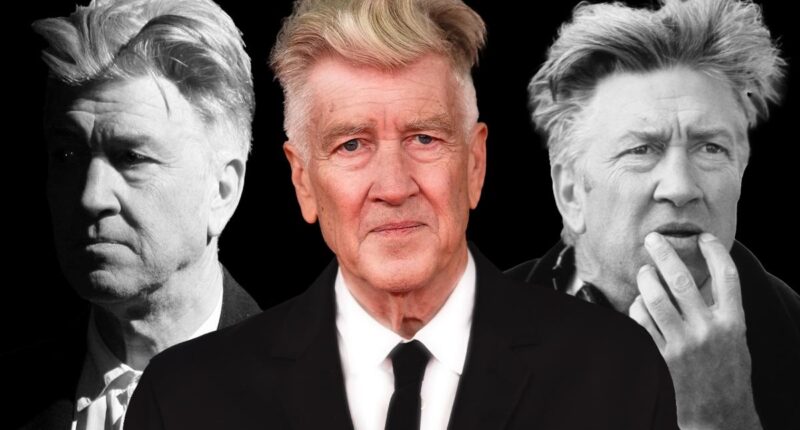David Lynch had a unique perspective on the world, perceiving an underlying meaning and a quiet voice amidst the ordinary. He felt a sense of isolation in noticing the menace within everyday interactions that seemed devoid of true depth. Lynch expressed the struggle of those who saw the world differently, challenging the norms of societal expectations. He found kinship with other poets and philosophers like Thoreau and Wordsworth, who also delved into the complexities of human existence.
For I have learned
To look on nature, not as in the hour
Of thoughtless youth; but hearing oftentimes
The still, sad music of humanity,
Lynch’s work as a filmmaker was not merely experimental but deeply expressive. He captured a world filled with existential horror, using images that unveiled the surreal aspects of reality. Lynch’s films, akin to works by renowned artists like Goya and poets like Wallace Stevens, depicted a world where illusion and reality converged in unsettling ways. Through his art, Lynch revealed the horror lurking beneath the facade of normalcy.
For Lynch, suburbia symbolized a facade of artificial perfection, reminiscent of old Hollywood’s manufactured glamour. Drawing inspiration from Victor Fleming’s “The Wizard of Oz,” Lynch portrayed a world where darkness and twisted desires lurked beneath the glossy veneer. His characters, like Laura Dern’s Lula in “Wild at Heart,” navigated a landscape of moral ambiguity and hidden truths, mirroring the internal struggles portrayed in Anne Sexton’s writing. Through his films, Lynch explored the dichotomy between facade and reality, exposing the unsettling truth that lies beneath the surface of everyday life.
Maybe that’s why there are so many lobotomized figures in his work like the massively brain-damaged survivor (Sherilyn Fenn) of a car wreck in Wild At Heart, poor Andy (Michael Massee) on the corner of a glass table in Lost Highway, or the Yellow Man (Fred Pickler) in Blue Velvet, shot through the head but alive somehow in another Dorothy’s (not of Kansas) bedroom. The hero of Blue Velvet watches Yellow Man’s arm spasming into a lampshade like the jaws of a beheaded snake, snapping in defiance to the idea that action requires volition. The trick of The Wizard of Oz is that it was Kansas all along, but David Lynch was never fooled. The farm hands are tin men and scarecrows. Witches are real. Maybe one lives by the dumpster behind this building. Maybe she keeps people she’s shrunken in a small, blue box. Sometimes the mask slips. Lynch wonders what would happen if people were to really listen to how everyone talks in circles about nothing and so his dialogue is circular and disconnected. The participants follow their own invisible threads. We only ever pretend to interact: we just wait for our turn. He’s not making a point, he’s listening better. He’s Gary Farmer’s Nobody in Jim Jarmusch’s Dead Man, the film’s David Lynch avatar who wonders how all the same white men run ahead of him to populate every city he passes; and imitates white men talking by opening and closing his mouth and saying nothing. Lynch’s first short film, The Alphabet (1968) is just a little girl in a simple white shift, sitting on her bed reciting the alphabet and it’s among the most disconcerting movies ever made. Lynch does intersperse a few surreal images, his style was already fully formed, but I understand how it works mainly through a passage from Douglas Adams’ The Hitchhiker’s Guide to the Galaxy in which he writes how counting at a robot is like chanting “blood” at a person. The Alphabet is terrifying because David Lynch is exposing the arbitrariness of language to a machine, us, that relies on it to perpetuate the noble myth of itself.
Isn’t it strange? Isn’t it all so terribly odd? Have you ever noticed how performers are often closer to authenticity than audiences in David Lynch films? Is it because we are all performers all of the time? Like Rebekah Del Rio in Mulholland Drive who warns Diane (Naomi Watts) and Rita (Laura Harring), the White Lodge/Black Lodge of Twin Peaks’ Nez Pearce tribe made manifest, that her upcoming performance of Roy Orbison’s “Crying” is not real. We know it’s not real because it’s a movie and they know it’s not real because it’s a show in a theater and they are fooled and so are we because of all of the things we have been conditioned to do, accepting the lie of an objective reality is the first. Our survival as a species is owed entirely to our ability to take lessons from the stories we tell one another as truth. Remember how The Man From Another Place (Michael J. Anderson) follows the phantom of Laura Palmer (Sheryl Lee) into the herringbone lounge of the Black Lodge, speaking backwards about secrets and deceptive appearances under the dead, blank eyes of a plaster statue of the Goddess of Love? Remember the trinity nuclear test in White Sands that Lynch recreates in his career-defining masterpiece Twin Peaks: The Return? How about the nuclear family of bunnies doing nuclear man things in a living room in Inland Empire? All of it is absolutely clear and none of it is easily explicable. David Lynch’s medium is the ineffable. Humans by their nature are unnatural and David Lynch sees through. If we are uncomfortable, it’s because he rejects language as insufficient to communicate his truth. When he lobbied for his muse, Laura Dern, to win consideration for her performance in Inland Empire, he sat by the side of Hollywood Blvd. in a folding chair bracketed by a giant banner of Dern to his left and a Holstein-Friesian dairy cow on his right. Lynch cracked our code, you see. This tableaux includes every single bit of information we need to be distracted by it, to be inspired to interpret it, to have it lodge in our memories for possibly the rest of our lives.
Did I tell you David Lynch recorded three studio albums? BlueBob, Crazy Clown Time and The Big Dream? He produced soundtrack albums, spoken-word albums, and collaborated with other artists on their work. He collaborated with the great Angelo Badalamenti on seven projects. When I was in high school, an hourly clerk at our local MusicLand, I remember how many copies of Julee Cruise’s Floating Into the Night we sold on the strength of Twin Peaks.
Lynch and Badalamenti wrote the music and lyrics for her, a voice Lynch called “soft and pure, and just what the doctor ordered.” Badalamenti said about using Cruise in Twin Peaks that she served a dual purpose, to “contrast the visuals and set the tone for the show.” Lynch visualized their collaboration in a concert film called Industrial Symphony #1: The Dream of the Broken Hearted (1990) which is more an extension of Wild at Heart (and an umbilicus linking to Lost Highway in seven years time and Mulholland Drive in eleven) with Laura Dern and Nicolas Cage offering a framing story involving the end of a relationship to an elaborate stage production that is itself more hallucination than your typical live performance. On the scale of the arts, music and poetry sit at the pinnacle of those products of the human hand closest to the divine and Lynch’s films are rich with the poetry of fulsome needledrops. Martin Scorsese is known for being a master of marrying the thrum of his pictures with popular music. I don’t know if Lynch is known enough for the same. David Bowie, Roy Orbison, Slaughterhouse’s “Power Mad” as the curative for a litany of bad news on the radio that Lula correctly identifies as also the opening for Night of the Living Dead, and Lou Reed, Rammstein and Nina Simone: the ecstatic choir of Lynch’s church of the dreaming.
Lynch started practicing Transcendental Meditation in 1973, 52 years ago, meditating twice a day without fail. That’s around 38,000 times. That’s a lot of time to spend in the deep. He said it gave him “effortless access to unlimited reserves of energy, creativity and happiness deep within. This level of life is sometimes called ‘pure consciousness’ – it is a treasury. And this level of life is deep within us all.” He started his namesake foundation pushing it in 2005 in order to teach people how to achieve this higher state of consciousness. He wrote a crystalline autobiography called Room to Dream and a guide to living called Catching the Big Fish: Meditation, Consciousness, and Creativity in which he compared his creative process with going for the “big fish” in the deep waters where they live. He says “there are all kinds of fish down there” and, in fact, “there are fish for everything.” Watching his movies is agreeing to fill your lungs and take the plunge down into a close, fathomless black, with Lynch, a veteran of tens of thousands of dives, your guide. There is rapture down there if you have eyes to see it. He writes “It’s so magical, I don’t know why, to go into a theater and have the lights go down. It’s very quiet, and then the curtains start to open. Maybe they’re red. And you go into a world.”
For Lynch, curtains hid the Wizard and reveal the truth. His movies aren’t surreal: they are only real. In Eraserhead, reluctant father and some-time shut-in Henry (Jack Nance) projects his consciousness into his radiator where a woman (Laurel Near) on a (red?) curtained stage sings a song David Lynch wrote for his film called “In Heaven.” It only has one lyric: the promise, or the prayer (the mantra? the lullabye?) that in Heaven, everything is fine. Reality, performance, sexuality, hunger… Lynch was only ever making one film. From 1968 through 2022, his entire body of work is one single chant married to one extended and perfectly complete meditation.
That’s why I don’t have a favorite David Lynch film. I love each of them individually but not as much as I love all of them as a whole. In truth, I don’t know if you can assess his films individually with nearly as much profit as in the context of what is now a completed work — a life’s work, a masterpiece, a memoir of the inner life of an artist vividly present and in conversation with himself. People point to The Straight Story or Dune or The Elephant Man as aberrations but, you know, I don’t think so. I think they’re all reflections of his vision. I don’t mean in terms of philosophy or ethos although it’s both of those, rather I mean his movies are each only how he sees others and their place in the order of things. They’re only assemblages of lies that seek to tell the truth, juxtapositions of constructed images to produce a single image, jumbles of disparate noise to nail one, pure, ringing tone. The Straight Story is about people who exist without affect and so the film is largely unaffected; The Elephant Man is about a man who is helpless due to circumstance to ever be anything but himself; Dune is Lynch’s attempt at opera – the absolute apex of playacting and unfiltered melodrama where language, that thing with which he has always been obsessed, becomes a thing capable of being sharpened into a deadly colonial weapon. What could be more Lynchian than a hollow planet teeming with worms? What could be more Lynchian than worms attracted by rhythm that excrete a psychotropic drug that opens the doorways of perception?
I will say, though, that there are moments in his films that are my favorites. When Robert Blake’s Mystery Man in Lynch’s Vertigo, Lost Highway (1997) first meets our hero Fred (Bill Pullman) at a party and lends him his phone, for instance, an unhinged minute of screentime that has disturbed and unbalanced me for 28 years now. “Llorando” and “Every Little Star” and the audition sequence from Mulholland Drive (and the dumpster); Dean Stockwell lip-synching “In Dreams” into a cage light and all of Dennis Hopper in Blue Velvet; all that dancing on lonesome highways in the cones of headlamps and all the slow push-ins as the soundtrack gets thick and noisy so we’re pulled into the screen as though we were attached to it with tenterhooks. All the dreams. All the nightmares and what’s the difference between them, anyway: one causes suffering when it falls through your fingers like sand upon waking; the other while you live it. I love the moment in The Straight Story when old Alvin Straight (Richard Farnsworth), given a bad diagnosis that includes a fatal emphysema, sleeps outdoors one night with his grown, disabled daughter, and tells her “Look up at the sky, Rosie. The sky is sure full of stars tonight” with so much love in his eye and his voice that there is not one chance this illusion isn’t absolute truth. And I love the end of The Elephant Man when John Merrick (John Hurt) has the best day he has ever had, and knows it, and the screen goes black while his lost mother (Phoebe Nicholls) provides her abandoned son, abandoned no more and finally seen for the man he is, his epitaph: “Never,” she says, “Oh, never. Nothing will die. The stream flows, the wind blows, the cloud fleets, the heart beats. Nothing will die.”
David Lynch left this part of his journey with us on January 16, 2025 at the age of 78. He is survived by his art, this beautiful, impossible, meticulous bathymetric map of the mountains and valleys of what lies far beneath. It is a map without a legend — more an invitation than a map, really — to follow him through caverns measureless to man down to a sunless sea. He was a rare thing: David Lynch was a poet in a new medium. Like every great poet, he made everyone who vibrated at a sympathetic frequency aware they weren’t doomed to be misunderstood among people programmed, for their own security, to misunderstand them. He transcended the barriers between the conscious and unconscious, even the ones that separate people from one another. We are, after all, not different from one another, not really. We are both here and at your house, don’t you remember? We have all met each other before and we will meet again soon. He only ever showed us what he saw. When you can do that, like the Weird Sisters sharing a single eye passed between them, the cloud fleets and the heart beats and nothing that is immortal can die.
Walter Chaw is the Senior Film Critic for filmfreakcentral.net. His book on the films of Walter Hill, with introduction by James Ellroy, is now available for purchase.
(function(d, s, id) {
var js, fjs = d.getElementsByTagName(s)[0];
if (d.getElementById(id)) return;
js = d.createElement(s); js.id = id;
js.src = “//connect.facebook.net/en_US/sdk.js#xfbml=1&appId=823934954307605&version=v2.8”;
fjs.parentNode.insertBefore(js, fjs);
}(document, ‘script’, ‘facebook-jssdk’));
















